Effects
HH Electronic IC-100
Posted on 07/12/2013 by ozzy in Amps, Effects
It was quite common to see Pink Floyd with the HH Electronic IC-100 amps on stage in the early 70s. While the rest of the band used their IC-100s only as pre-amps, Roger Waters used it also together with a Binson Echorec delay unit to produce a tremolo effect. (See One of These Days track, 2:00 - 2:30).
"One day, Roger decided to take some of the techniques that I was developing and try them out himself on bass. And he came up with that basic riff that we all worked on and turned into One of these Days," says Gilmour to Guitar World magazine.
"For the middle section, another piece of technology came into play: an H&H amp with vibrato (sic). I set the vibrato to more or less the same tempo as the delay. But the delay was in 3/4 increments of the beat and the vibrato went with the beat. I just played the bass through it and made up that little section, which we then stuck on to a bit of tape and edited in. The tape splices were then camouflaged with cymbal crashes."
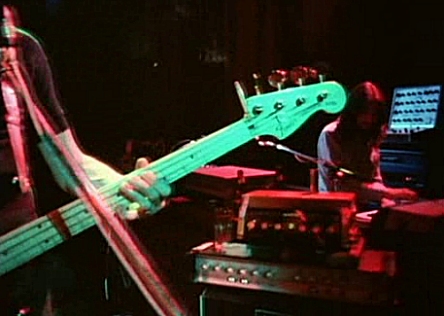
The IC-100 solid state amps were manufactured by the UK company HH Electronic (now owned by Laney). They offered the 100 watts RMS of undistorted output, two channels with a full range of tone controls and a volume control on each channel. Each channel had two inputs, normal and bright. In addition to a Volume, Treble and Bass knobs, the amp had a Presence control on channel 1 and a Brilliance on channel 2. On the first channel there was a Sustain that fattened-up the sound by adding an extra gain/harmonics in parallel to the existing signal. Effects (controlable with a footswitch) included a Reverb and Tremolo.
Posted in Amps, Effects | Please leave your comment
EMS Studio-System Vocoder 5000
Posted on 24/01/2012 by ozzy in Effects
A vocoder is a type of sound effect that can turn the human voice into a robot sounding like voice. Roger Waters used a vocoder in Animals for his lead vocals in Pigs and for the Psalm 23 (The Lord is my shepherd...) parody in Sheep, as well as for the barking sounds and other effects in Dogs. Rick’s keyboards were also fed through the vocoder, notably during the middle section of Dogs.
It is reported that Pink Floyd used a Korg VC-10 but this sounds unlikely as the VC-10 model was introduced in 1978 and Floyd recorded Animals in their new studio Britannia Row between April and December 1976. However, it may be possible - through Floyd’s established association with the UK-based EMS (see VCS3) and because of the production date (1976) of EMS’ vocoder device - that Floyd might as well have used the EMS Studio-System Vocoder 5000.
Source: Spare Bricks
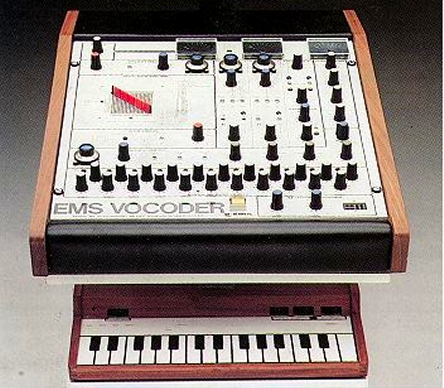
Posted in Effects | Please leave your comment
EMS VCS3 and EMS Synthi AKS
Posted on 17/01/2012 by ozzy in Effects
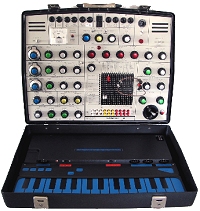 "Pink Floyd's Dark Side Of The Moon is famous for its
extensive use of the VCS3 by Roger Waters, and On The Run
is perhaps the classic VCS3 track... but there is no VCS3 on it!" says Sound
On Sound magazine in its article 'All
about EMS'. "Alan Parsons (the engineer on the album) later revealed
that the track was recorded using a Synthi AKS. It was, as he put
it, the 'hot synth of the year'.
"Pink Floyd's Dark Side Of The Moon is famous for its
extensive use of the VCS3 by Roger Waters, and On The Run
is perhaps the classic VCS3 track... but there is no VCS3 on it!" says Sound
On Sound magazine in its article 'All
about EMS'. "Alan Parsons (the engineer on the album) later revealed
that the track was recorded using a Synthi AKS. It was, as he put
it, the 'hot synth of the year'.
Because of the lack of synchronisation technology at the time, the track (except for the spun-in sound effects) was recorded live. The sequence was laboriously programmed using the AKS's membrane keyboard, and then played back at high speed to produce the effect that you hear. Considering the complexity of the sequence, the amount of sound modulation going on, and the hi-hat sound that is also being produced by the synth, it's remarkable that everything worked as well as it did. More so when you realise that the same rigmarole was required before every concert -- there were no stage sequencers in 1972!"
The original VCS 3 is a portable analog synthesiser developed by Electronic Music Studios (EMS) in 1969. It has three oscillators, and a unique matrix-based patch system. Instead of patch wires, the VCS3 uses a patchbay grid in which the synth components are laid out, and signal routing is accomplished by placing small pins into the appropriate slots. The VCS3's basic design was reused by EMS in many other of their own products, most notably in the EMS Synthi AKS (1972) which had a built-in membrane keyboard and sequencer.
Source: Sound On Sound, Wikipedia
Posted in Effects | Please leave your comment
Pete Cornish pedalboard
Posted on 28/12/2011 by ozzy in Effects
Roger Waters started using his Pete Cornish custom pedalboard during In the Flesh tour (1977) and he continued using it on The Wall tour (1980-81). Surprisingly enough, this pedalboard could also be seen on stage during some of The Dark Side of the Moon Live shows in 2006 (see photos at Neptune Pink Floyd) and during the Wall shows, where it was kept in the back and controlled by Roger's guitar tech Colin Lyon.
Roger's pedalboard contains only two effects - Electro Harmonix Bassballs and MXR Phase 90, send/return switch for MXR Digital Delay, switch for spare amp, volume pedal, and output for Floyd's typical Conn Strobotuner ST-11. He now primarily uses the Bassballs, while the delays are controlled manualy via rackmounted TC Electronic D-Two units (Another Brick in the Wall, part II).
In the interview for Total Production International (TPi) magazine, Gilmour's guitar tech Phil Taylor explains the role of pedalboards in the original concert production of The Wall: “I was with the band while they were recording in America, and had to work out how many pedalboards I needed for the show. I ended up with 11, and because there were no faxes back then, I had to send drawings to Pete Cornish [famed custom equipment designer] by express mail and discuss them with him on the phone."
“We were not only adding a second guitarist — we also now had a second bass player who needed his own board, plus we had a complete second stage to equip and I needed another four mini pedalboards for this. I already had some spare send and return units to cover unseen eventualities. I put it all together by working out with David and Roger exactly which effects would be needed for the songs performed on each stage, and then making the boards as compact as possible by including only the necessary effects for each situation."
“Getting all those made when we were thousands of miles away from Pete was a bit of a headache, but he is someone who can always be relied on to deliver the goods.” Read the whole article here.
Source: Pete Cornish, TPi magazine
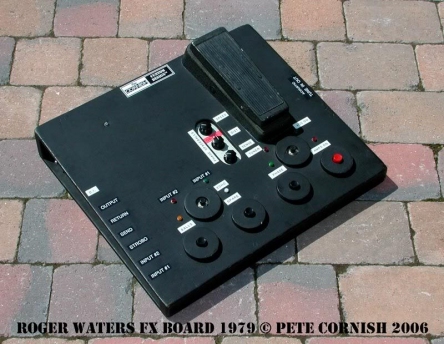
Posted in Effects | Please leave your comment
Dallas-Arbiter Fuzz Face (germanium)
Posted on 21/11/2011 by ozzy in Effects
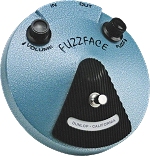 Roger Waters often used a Dallas-Arbiter Fuzz Face (germanium
model) in the early days, notably on Echoes during the build up
from the mid section. The Fuzz Face is an effect pedal that was designed
to produce a distorted sound that reminds a sound of a damaged speaker.
The Fuzz Face was used mainly by electric guitarists (Jimi Hendrix,
David Gilmour, Pete Townshend), and by some bass players (Roger Waters).
Roger Waters often used a Dallas-Arbiter Fuzz Face (germanium
model) in the early days, notably on Echoes during the build up
from the mid section. The Fuzz Face is an effect pedal that was designed
to produce a distorted sound that reminds a sound of a damaged speaker.
The Fuzz Face was used mainly by electric guitarists (Jimi Hendrix,
David Gilmour, Pete Townshend), and by some bass players (Roger Waters).
The pedal circuit only uses eleven electronic components, one battery, plus two knobs that control volume and the amount of "fuzz" the pedal produces. The earliest units used germanium transistors, which were capable of producing a wide range of tones. Later on silicon transistors were used to provide a more stable operation, but have a different, harsher sound. At the time the box was first made, the tolerances of electric components were not as tight as they are today. As a result, two circuits utilizing the same components might sound quite different. In addition, germanium transistors tend to be sensitive to temperature, so the sound produced using the box would change as the equipment heated up. According to some sources, professional musicians would try different units from a batch in order to find one which sounded the best to their ears.
Arbiter first issued the Fuzz Face in 1966, later units bear the Dallas-Arbiter name. The original Fuzz Face was discontinued in 1974, in 1993 Jim Dunlop took over production and still makes the pedal. Germanium and silicon transistor versions are available.
Source: Wikipedia
Posted in Effects | Please leave your comment
Binson Echorec 2
Posted on 15/09/2011 by ozzy in Effects
1968 - 1977
Binson was an early manufacturer of echo machines. Unlike most other analogue echo machines, they used an analogue magnetic drum recorder instead of the tape loop. Their most famous product was the Binson Echorec.
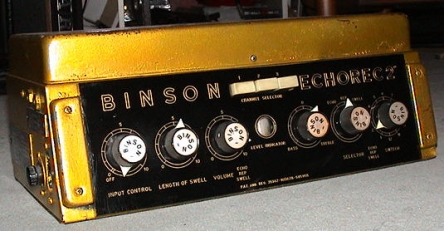
In Pink Floyd's 23-minute long song Echoes, Roger Waters used a Binson Echorec to create the eerie underwater wind noise heard during the first interlude (10:40-15:02 on studio recordings, underneath the screaming seagull sound produced by Gilmour); he vibrated the strings of his bass guitar with a steel slide and fed the sound through the Echorec. Waters reproduced this sound during live performances.
Also One of These Days is an another typical example where the Binson Echorec was used on the bass. In the interview for Guitar World, Gilmour explains: "One of these Days evolved from some of my experiments with the Binson, as did Echoes. One day, Roger decided to take some of the techniques that I was developing and try them out himself on bass. And he came up with that basic riff that we all worked on and turned into One of these Days. The opening section is me and Roger. For some reason, we decided to do a double track of the bass. You can actually hear it if you listen in stereo. The first bass is me. A bar later, Roger joins in on the other side of the stereo picture. We didn't have a spare set of strings for the spare bass guitar, so the second bass is very dull sounding. We sent a roadie out to buy some strings, but he wandered off to see his girlfriend instead."
The Binson Echorec was a major part of the Pink Floyd sound-image until 1977.
Source: Wikipedia, Guitar World
Posted in Effects | Please leave your comment
Hiwatt Custom 100 DR103 and WEM Super Starfinder 200
Posted on 14/09/2011 by ozzy in Amps, Effects
1971 - 1978
During most of the 70s Roger's rig consisted of Hiwatt Custom 100 DR103s and WEM Super Starfinder 200 (4x12) cabinets. This setup would last utnil about 1978 when Phil Taylor built him a new Phase Linear 700 amplified bass rig.
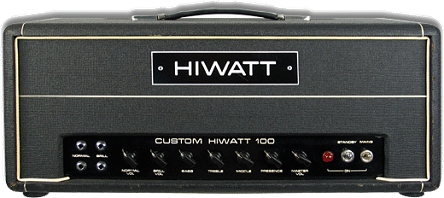
In the 1970 the band also used HH Electronic IC-100 solid state amps, setting them as pre-amps (see the Live at Pompeii). Roger also used one on One of These Days for the echoed tremolo effect (see 2:00 - 2:30 on studio recordings). The IC-100s was later replaced with Alembic F2-B amplifiers to serve the same purpose.

On the below picture you can see Roger's rig he used during the live performance of The Dark Side of the Moon at Brighton in 1972 - a Hiwatt amp, HH Electronic IC-100 pre-amp, and Binson Echorec on top.
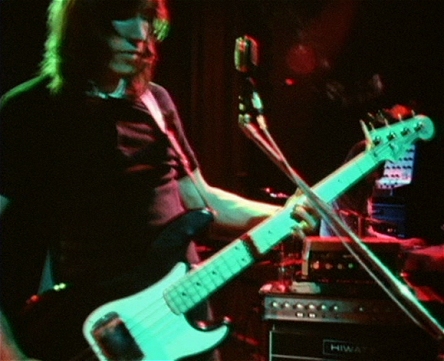
Posted in Amps, Effects | Please leave your comment
Electro Harmonix Bassballs
Posted on 14/09/2011 by ozzy in Effects
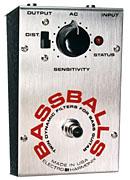 The Bassballs was featured in Roger's (and Andy Bown's) Pete Cornish
Wall stage pedalboards and was used notably on Thin Ice and Young
Lust.
The Bassballs was featured in Roger's (and Andy Bown's) Pete Cornish
Wall stage pedalboards and was used notably on Thin Ice and Young
Lust.
This box is a typical envelope filter or auto-wah. Depending on the dynamics of your playing, the frequency filter creates a wah-kind-of-effect similar to the sound of vowels.
To control the effect you need just one potentiometer that determines the frequency range and one switch to turn on/off a fuzz type distortion.
Within their Nano product range Electro-Harmonix (EHX) recently released the scaled down version of Bassballs.
Posted in Effects | Please leave your comment
MXR Phase 90
Posted on 14/09/2011 by ozzy in Effects
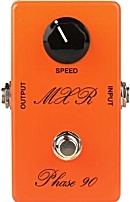 The original MXR Phase 90 was released in 1974, and it was the
first pedal sold by MXR. Roger Waters used it during the 1974-75 and
1977 tours, mainly for Raving and Drooling (an early version of Sheep).
The original MXR Phase 90 was released in 1974, and it was the
first pedal sold by MXR. Roger Waters used it during the 1974-75 and
1977 tours, mainly for Raving and Drooling (an early version of Sheep).
MXR Phase 90 is a stompbox that do the signal modulation - the phase shifting. In general, a phase shifter is a device that alters the sound of a signal by making a delayed copy of the sound and recombining that copy with the original signal. Because the two signals are shifted slightly in time, this leads to a characteristic change in the timbre of the resulting signal.
When Jim Dunlop bought the MXR brand in 1987, production resumed. The Dunlop production models have modern additions including an LED to indicate when the effect is engaged and the option of using a power supply instead of a battery. There are a few variants available, including an Eddie Van Halen signature model. The 1974 Hand Wired Phase 90 is a recreation of an original 1974 pedal using NOS (New Old Stock) electronic components.
Source: Wikipedia
Posted in Effects | Please leave your comment
TC Electronic D-Two
Posted on 14/09/2011 by ozzy in Effects
2010 - Present
TC Electronic D-Two Multi-Tap Rhythm Delay is based on the TC 2290. The D-Two can provide up to 10 seconds of delay, features 24-bit A/D-D/A conversion and 24-bit internal processing, comes with 50 factory presets and 100 user, and provides S/PDIF digital I/O at 44.1kHz and 48kHz. 6 unique direct-access features include Spatial (provides extra-wide delay at a single keystroke), Ping-Pong (pick any 5 patterns and set the relationship between panning speed and delay tempo), Reverse (reverse delay with the flick of a key), Dynamic (sets the release time and threshold to let the input signal control level of delay), Chorus (hit a single key to instantly add chorus or flange to your delay), and Filter (increases filtering as repeats decay). With the D-Two you are able to tap actual rhythm patterns consisting of up to 10 taps directly into the unit.
On the below picture you can see the rack of delays as used on The Wall tour in 2012. The rack includes Samson PowerBrite PB10 power conditioner and Korg DTR-2000 tuner.
Source: TC Electronic, Premier Guitar
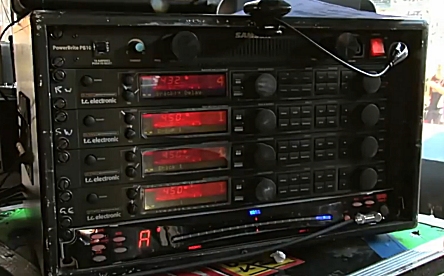
Posted in Effects | Please leave your comment
MXR Digital Delay
Posted on 14/09/2011 by ozzy in Effects
1977 - 2010
In 1977 band replaced their Binson Echorec 2 units with rackmount digital devices by MXR. MXR Digital Delays were usualy shipped with one 320 ms delay chip while the expansion model - containing four chips - produced up to 1.28 seconds of delay.
I don't know about Waters but Gilmour's rig, for instance, included two MXR Digital Delay units and two upgraded MXR Digital Delay System II units working simultaneously, each with the different tap.


